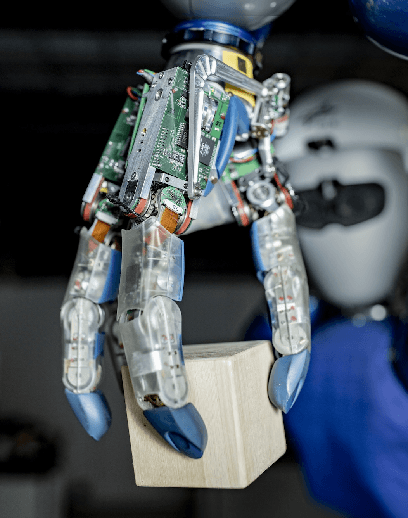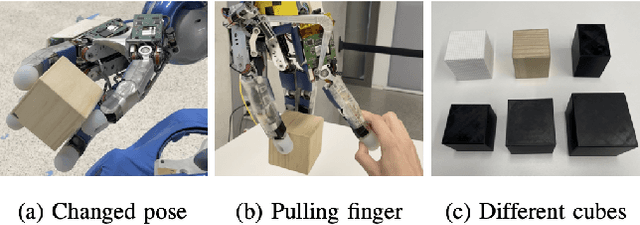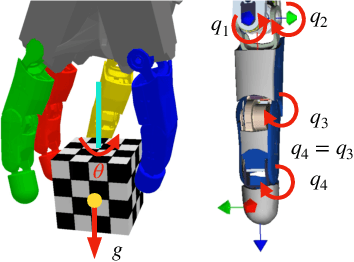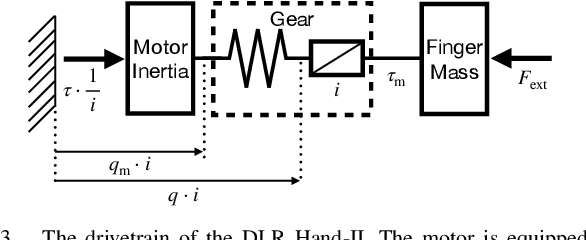Leon Sievers
Composing Dextrous Grasping and In-hand Manipulation via Scoring with a Reinforcement Learning Critic
May 19, 2025Abstract:In-hand manipulation and grasping are fundamental yet often separately addressed tasks in robotics. For deriving in-hand manipulation policies, reinforcement learning has recently shown great success. However, the derived controllers are not yet useful in real-world scenarios because they often require a human operator to place the objects in suitable initial (grasping) states. Finding stable grasps that also promote the desired in-hand manipulation goal is an open problem. In this work, we propose a method for bridging this gap by leveraging the critic network of a reinforcement learning agent trained for in-hand manipulation to score and select initial grasps. Our experiments show that this method significantly increases the success rate of in-hand manipulation without requiring additional training. We also present an implementation of a full grasp manipulation pipeline on a real-world system, enabling autonomous grasping and reorientation even of unwieldy objects.
Learning Time-Optimal and Speed-Adjustable Tactile In-Hand Manipulation
Nov 20, 2024



Abstract:In-hand manipulation with multi-fingered hands is a challenging problem that recently became feasible with the advent of deep reinforcement learning methods. While most contributions to the task brought improvements in robustness and generalization, this paper addresses the critical performance measure of the speed at which an in-hand manipulation can be performed. We present reinforcement learning policies that can perform in-hand reorientation significantly faster than previous approaches for the complex setting of goal-conditioned reorientation in SO(3) with permanent force closure and tactile feedback only (i.e., using the hand's torque and position sensors). Moreover, we show how policies can be trained to be speed-adjustable, allowing for setting the average orientation speed of the manipulated object during deployment. To this end, we present suitable and minimalistic reinforcement learning objectives for time-optimal and speed-adjustable in-hand manipulation, as well as an analysis based on extensive experiments in simulation. We also demonstrate the zero-shot transfer of the learned policies to the real DLR-Hand II with a wide range of target speeds and the fastest dextrous in-hand manipulation without visual inputs.
Learning a Shape-Conditioned Agent for Purely Tactile In-Hand Manipulation of Various Objects
Jul 26, 2024Abstract:Reorienting diverse objects with a multi-fingered hand is a challenging task. Current methods in robotic in-hand manipulation are either object-specific or require permanent supervision of the object state from visual sensors. This is far from human capabilities and from what is needed in real-world applications. In this work, we address this gap by training shape-conditioned agents to reorient diverse objects in hand, relying purely on tactile feedback (via torque and position measurements of the fingers' joints). To achieve this, we propose a learning framework that exploits shape information in a reinforcement learning policy and a learned state estimator. We find that representing 3D shapes by vectors from a fixed set of basis points to the shape's surface, transformed by its predicted 3D pose, is especially helpful for learning dexterous in-hand manipulation. In simulation and real-world experiments, we show the reorientation of many objects with high success rates, on par with state-of-the-art results obtained with specialized single-object agents. Moreover, we show generalization to novel objects, achieving success rates of $\sim$90% even for non-convex shapes.
Self-Contained and Automatic Calibration of a Multi-Fingered Hand Using Only Pairwise Contact Measurements
Nov 07, 2023Abstract:A self-contained calibration procedure that can be performed automatically without additional external sensors or tools is a significant advantage, especially for complex robotic systems. Here, we show that the kinematics of a multi-fingered robotic hand can be precisely calibrated only by moving the tips of the fingers pairwise into contact. The only prerequisite for this is sensitive contact detection, e.g., by torque-sensing in the joints (as in our DLR-Hand II) or tactile skin. The measurement function for a given joint configuration is the distance between the modeled fingertip geometries, but the actual measurement is always zero. In an in-depth analysis, we prove that this contact-based calibration determines all quantities needed for manipulating objects with the hand, i.e., the difference vectors of the fingertips, and that it is as sensitive as a calibration using an external visual tracking system and markers. We describe the complete calibration scheme, including the selection of optimal sample joint configurations and search motions for the contacts despite the initial kinematic uncertainties. In a real-world calibration experiment for the torque-controlled four-fingered DLR-Hand II, the maximal error of 17.7mm can be reduced to only 3.7mm.
Estimator-Coupled Reinforcement Learning for Robust Purely Tactile In-Hand Manipulation
Nov 07, 2023



Abstract:This paper identifies and addresses the problems with naively combining (reinforcement) learning-based controllers and state estimators for robotic in-hand manipulation. Specifically, we tackle the challenging task of purely tactile, goal-conditioned, dextrous in-hand reorientation with the hand pointing downwards. Due to the limited sensing available, many control strategies that are feasible in simulation when having full knowledge of the object's state do not allow for accurate state estimation. Hence, separately training the controller and the estimator and combining the two at test time leads to poor performance. We solve this problem by coupling the control policy to the state estimator already during training in simulation. This approach leads to more robust state estimation and overall higher performance on the task while maintaining an interpretability advantage over end-to-end policy learning. With our GPU-accelerated implementation, learning from scratch takes a median training time of only 6.5 hours on a single, low-cost GPU. In simulation experiments with the DLR-Hand II and for four significantly different object shapes, we provide an in-depth analysis of the performance of our approach. We demonstrate the successful sim2real transfer by rotating the four objects to all 24 orientations in the $\pi/2$ discretization of SO(3), which has never been achieved for such a diverse set of shapes. Finally, our method can reorient a cube consecutively to nine goals (median), which was beyond the reach of previous methods in this challenging setting.
Dextrous Tactile In-Hand Manipulation Using a Modular Reinforcement Learning Architecture
Mar 08, 2023



Abstract:Dextrous in-hand manipulation with a multi-fingered robotic hand is a challenging task, esp. when performed with the hand oriented upside down, demanding permanent force-closure, and when no external sensors are used. For the task of reorienting an object to a given goal orientation (vs. infinitely spinning it around an axis), the lack of external sensors is an additional fundamental challenge as the state of the object has to be estimated all the time, e.g., to detect when the goal is reached. In this paper, we show that the task of reorienting a cube to any of the 24 possible goal orientations in a ${\pi}$/2-raster using the torque-controlled DLR-Hand II is possible. The task is learned in simulation using a modular deep reinforcement learning architecture: the actual policy has only a small observation time window of 0.5s but gets the cube state as an explicit input which is estimated via a deep differentiable particle filter trained on data generated by running the policy. In simulation, we reach a success rate of 92% while applying significant domain randomization. Via zero-shot Sim2Real-transfer on the real robotic system, all 24 goal orientations can be reached with a high success rate.
Learning Purely Tactile In-Hand Manipulation with a Torque-Controlled Hand
Apr 12, 2022



Abstract:We show that a purely tactile dextrous in-hand manipulation task with continuous regrasping, requiring permanent force closure, can be learned from scratch and executed robustly on a torque-controlled humanoid robotic hand. The task is rotating a cube without dropping it, but in contrast to OpenAI's seminal cube manipulation task, the palm faces downwards and no cameras but only the hand's position and torque sensing are used. Although the task seems simple, it combines for the first time all the challenges in execution as well as learning that are important for using in-hand manipulation in real-world applications. We efficiently train in a precisely modeled and identified rigid body simulation with off-policy deep reinforcement learning, significantly sped up by a domain adapted curriculum, leading to a moderate 600 CPU hours of training time. The resulting policy is robustly transferred to the real humanoid DLR Hand-II, e.g., reaching more than 46 full 2${\pi}$ rotations of the cube in a single run and allowing for disturbances like different cube sizes, hand orientation, or pulling a finger.
 Add to Chrome
Add to Chrome Add to Firefox
Add to Firefox Add to Edge
Add to Edge